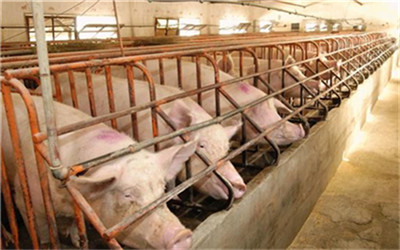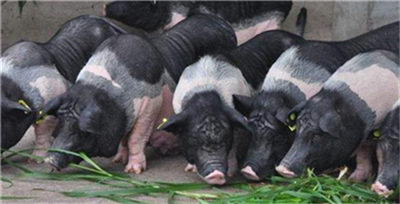Xiao Jiangen: I think piglets have diarrhea at 13:00
Piglet dysentery is a perplexing problem often encountered. When I watch piglet diarrhea on the spot, I pay special attention to the following 13:00 problem, and then find the cause to solve the problem.
The following is my experience in solving the problem of piglet dysentery, especially for piglets within a week of birth. As long as there is a slight negligence or a little wind, the phenomenon of piglet dysentery will follow, increasing the burden of work and the cost of medication.
1. Pathogen infection
Disease is the main cause of diarrhea in piglets, such as Escherichia coli, Clostridium, Salmonella, rotavirus, classical swine fever virus, influenza virus, transmissible gastroenteritis virus (TGE), are common pathogens. Proper medication, strengthening disinfection and management, preventive injection in sows and supplementation of electrolytes and vitamins in piglets are all effective ways of prevention and treatment.
two。 Thieving wind
In the delivery house, especially for newborn piglets, there must be no thieves in the delivery house, otherwise, once the piglets get cold, they will develop dysentery immediately. therefore, some wind protection facilities are necessary for piglets.
3. Temperature of heat preservation
Piglets are very sensitive to cold, so heat preservation is even more important. whether the indoor temperature is enough, whether the insulation lamp is in the right place, the type of the floor and the use of mattresses will directly affect the effect of heat preservation.

4. The change of temperature
The temperature difference between day and night is too large, which will also cause dysentery of piglets. The temperature difference in the house should not exceed 2 ℃, and the heat preservation rest area of piglets should not exceed 1 ℃.
5. Moisture (humidity)
The delivery bed must always be warm and dry for 24 hours, especially in the warm rest area of piglets.
6. Colostrum intake
Piglets must eat enough colostrum within 6 hours after birth to get enough antibody protection. at the same time, colostrum contains a high amount of milk fat, which can provide energy for piglets.
7. Drinking water
Drinking water is very important for piglets. Too low or unsanitary drinking water will cause piglets to develop dysentery.
8. Lack of milk or mastitis in sows
Once sows lack milk or have mastitis, piglets are hungry and cold because they are unable to eat enough breast milk, which often increases the chances of pathogens infecting piglets and causing diarrhea.
9. Weak piglet
The nipple competitiveness of weak piglets is worse than that of other normal piglets, so they must pay more attention to take care of them so that they can eat enough breast milk or substitute breast milk to increase their physical strength and reduce stress. Otherwise, once the weak piglets get sick with dysentery, it will be a carrier of germs for other healthy piglets in the same litter.
10. Care of piglets
During the period from birth to lactation, piglets must be injected with iron, cut teeth, cut umbilical cord, castration and so on. For piglets, although this is a necessary work, it will increase stress, so careful care and prevention of pathogens is an important key to reduce diarrhea.
11. Health management
A sick piglet with dysentery can easily transmit the pathogen to a healthy piglet by the operator's hands, boots or injection needles, so all used equipment must be properly cleaned and disinfected before it can be used again. Remember to deal with healthy piglets before dealing with dysentery piglets.
twelve。 Epidemic prevention of sows
Four weeks before parturition, the vaccine was injected into sows to produce antibodies and then transmitted to piglets through colostrum to improve piglets' resistance and effectively reduce the incidence of dysentery.
13. Cleaning and disinfection of delivery bed
The delivery bed is often a breeding place for residual pathogens, especially when piglets have diarrhea in the previous use, better cleaning and disinfection must be done before the next batch of sows enter the delivery house, otherwise the trouble of piglets with diarrhea will continue forever.
- Prev

Do you know that this situation causes the pig's body to turn red? Will it be treated?
Do you know that this situation causes the pig's body to turn red? Will it be treated?
- Next

There are six possibilities for a large number of bleeding spots in pig skin, do you know?
There are six possibilities for a large number of bleeding spots in pig skin, do you know?
Related
- On the eggshell is a badge full of pride. British Poultry Egg Market and Consumer observation
- British study: 72% of Britons are willing to buy native eggs raised by insects
- Guidelines for friendly egg production revised the increase of space in chicken sheds can not be forced to change feathers and lay eggs.
- Risk of delay in customs clearance Australia suspends lobster exports to China
- Pig semen-the Vector of virus Transmission (4)
- Pig semen-the Vector of virus Transmission (3)
- Five common causes of difficult control of classical swine fever in clinic and their countermeasures
- Foot-and-mouth disease is the most effective way to prevent it!
- PED is the number one killer of piglets and has to be guarded against in autumn and winter.
- What is "yellow fat pig"? Have you ever heard the pig collector talk about "yellow fat pig"?

